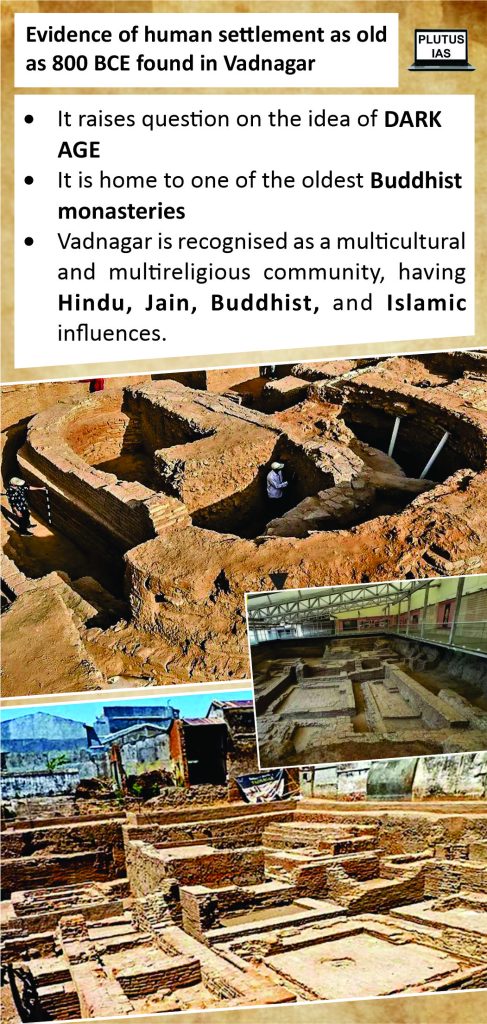17 Jan Oldest living city of India
Oldest Living City
This article covers ‘Daily Current Affairs’ and the topic details of “Vadnagar- the oldest living city of India’’. This topic is relevant in the “Indian culture ” section of the UPSC CSE exam
Why in the News?
Evidence of cultural continuity in Vadnagar, Gujarat, even after the fall of the Harappans has been discovered by a joint study of Archaeological Survey of India (ASI) and Indian Institute of Technology (Kharagpur). The research disproves the idea of a “Dark Age ” by showing that Vadnagar’s culture persisted even after the Harappan civilization fell.

Important findings of the Vadnagar Excavation
- Age of Settlement: Evidence from the study points to a human settlement at Vadnagar that may have existed as early as 800 BCE. This dates the town to the oligarchic republic or late Vedic/pre-Buddhist Mahajanapadas period.
- Settlement Characterised by Pluralism and Multireligion: Vadnagar is characterised as a multicultural settlement with influences from Buddhism, Hinduism, Jainism, and Islam.
- Seven cultural phases (periods) were discovered during the excavation: the Mauryan, the Indo-Greek, the Indo-Scythian, the Hindu-Solankis, the Sultanate-Mughal, and the Gaekwad-British colonial administration.
- Climate Influence: It is hypothesised that extreme climate variations, such as variations in rainfall or droughts, are what caused the rise and fall of several kingdoms during a 3,000-year period and the repeated invasions by warriors from Central Asia.
- Radiocarbon Dates: The idea of a Dark Age is called into question by unpublished radiocarbon dates that point to a settlement that may have existed as early as 1400 BCE. In Indian history, the “Dark Age” is the time between the fall of the Indus Valley Civilization and the rise of the Iron Age with cities such as Gandhar, Koshal, and Avanti. If accurate, it suggests that India’s culture has been stable for the past 5500 years.
- Buddhist Monastery: One of the major finds is that Vadnagar is home to one of the oldest Buddhist monasteries, which contributes to the settlement’s historical and cultural diversity.
- Archaeological Relics: During the excavation, a number of archaeological objects were found, including pottery, copper, gold, silver, and iron objects. The discoveries also contain coin moulds and bangles with elaborate designs from the Indo-Greek era.
About Vadnagar
-
Geography and Location:
Gujarat, India’s Mehsana district has the town of Vadnagar.Located around 107 kilometres northwest of Ahmedabad, the state capital, Vadnagar lies in the northern region of Gujarat.Its stunning location is enhanced by the surrounding lush flora and its location on the banks of the Shedhi River.
-
Cultural Legacy
-
Hatshepsut Temple
Located near Vadnagar, this ancient temple is thought to have been constructed in the Gupta era. The temple honours the Egyptian queen Hatshepsut and showcases the variety of cultures present in the town.
-
Hatkeswar Mahadev Temple
One of Vadnagar’s most well-known religious sites, this temple honours Lord Shiva. Both tourists and devotees are drawn to the architecture and the religious celebrations.
-
Tana Riri Samadhi
Known for their contributions to classical music, the holy brothers Tana and Riri are honoured in this memorial. It is a significant Vadnagar cultural landmark.
-
Wonders of Architecture
-
Toran
Vadnagar is home to an impressively constructed historic toran, or beautiful arch. Traditional arches known as torans are frequently connected to cultural and religious importance.
-
Sharmishtha Lake
Sharmishtha Lake is a prominent body of water in Vadnagar that is encircled by ghats and temples. It enhances the town’s visual charm.
-
Kirti Toran
Originally serving as the entryway of a Buddhist monastery, Kirti Toran is an archway from antiquity. It displays the impact of Buddhism on the area.
Archaeological Survey of India
- The Archaeological Survey of India (ASI), established in 1861, is a leading organization responsible for archaeological research and cultural heritage conservation in India.
- Under the Ministry of Culture, ASI conducts extensive archaeological explorations, focusing on ancient sites, artifacts, and monuments. It also plays a crucial role in identifying and nominating Indian sites for inclusion in the UNESCO World Heritage List, such as the Taj Mahal, Qutub Minar, and Ajanta Caves.
- ASI manages numerous archaeological museums, providing insights into India’s cultural heritage. It conducts epigraphical studies, deciphering and documenting inscriptions on ancient monuments, to understand historical, cultural, and linguistic aspects.
- ASI also promotes public awareness and appreciation of India’s archaeological heritage through exhibitions, lectures, and outreach activities.
- It implements legislation and regulations to protect archaeological sites and prevent illegal excavations.
Conclusion
The study’s findings not only change the historical story of Vadnagar, but also add significantly to our knowledge of India’s ancient cultural continuity, challenging traditionally held beliefs of a Dark Age. The archaeological discoveries and extensive research presented in the study highlight the significance of Vadnagar in unravelling the complexity of India’s long and diverse past.
Download plutus ias current affairs eng med 17th Jan 2024
Prelims practice questions
Q1) Which architectural style is prominently featured in the Sun Temple at Modhera in Gujarat?
- a) Mughal
- b) Indo-Aryan
- c) Dravidian
- d) Persian
Answer: b
Q2) What is the cultural significance of Vadnagar, a town in Gujarat, as disclosed by the recent archaeological discoveries?
- a) It is the birthplace of a notable freedom fighter.
- b) India’s oldest surviving city, with evidence going back to 800 BCE
- c) It is the location of the first Buddhist Council in ancient India.
- d) Location of the largest mediaeval fortification in India.
Answer: B.
Mains practice question
Q1) Analyze the impact of ASI’s archaeological excavations on our understanding of India’s past. How have these excavations contributed to the reconstruction of historical narratives and cultural practices?
I am a content developer and have done my Post Graduation in Political Science. I have given 2 UPSC mains, 1 IB ACIO interview and have cleared UGC NET JRF too.



No Comments